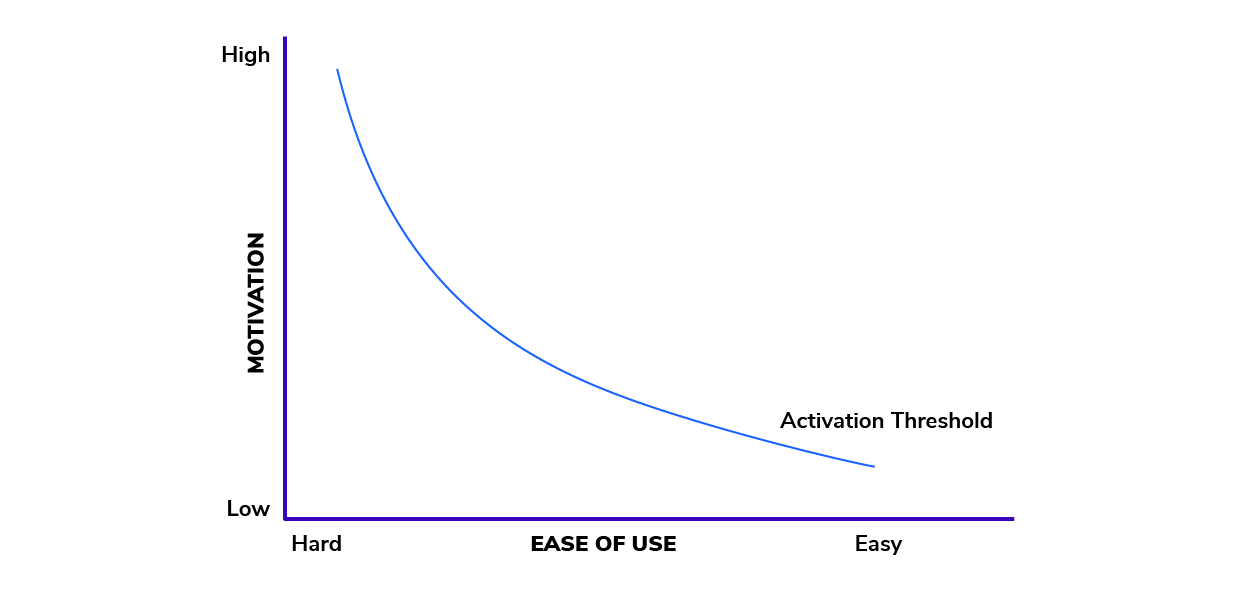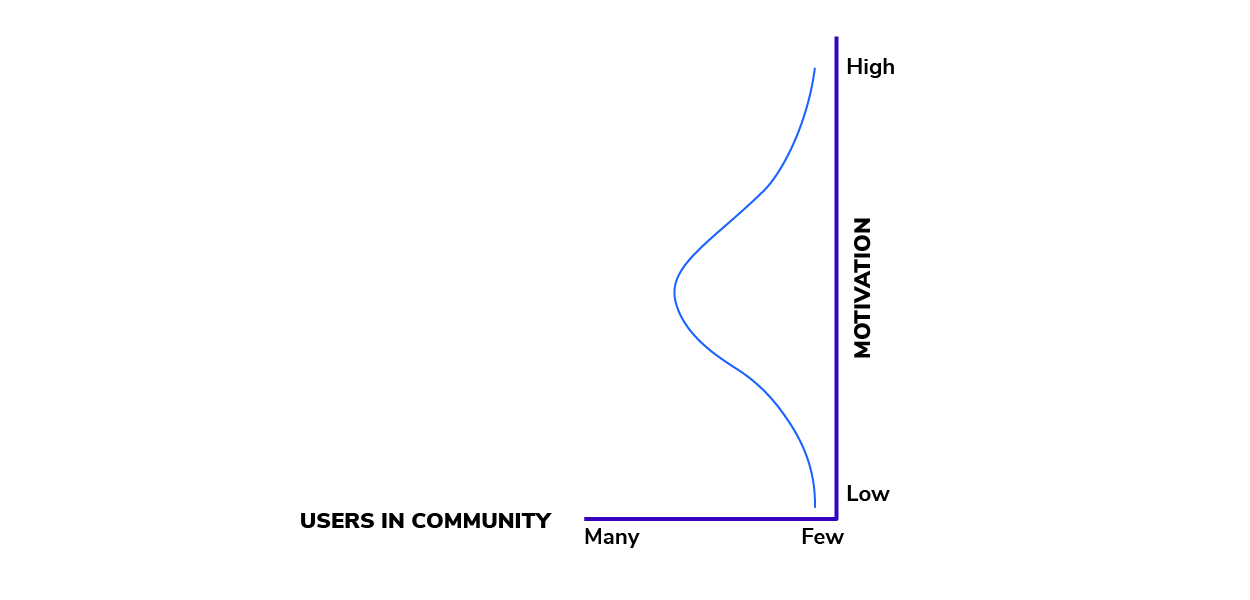Visualize the Impact of Your Digital Strategy

Technologists and marketers have at their disposal a broad range of tools and techniques to drive their businesses forward. And while implicitly everyone assumes these will help “move the needle” in the right direction, not everyone is aware of the actual implications of how each approach affects user engagement, the interplay between those factors, and the aggregate effect on results.
In order to get a better understanding, we have developed a framework that starts with BJ Fogg’s Behavior Model and extends it in a way that allows us to quickly see the implications of our actions depending on which approaches we chose to undertake. This, in turn, can also help us identify the initiatives with the greatest ROI depending on the perceived sensitivities and our ability to affect each of the outcomes.
BJ Fogg’s Behavior Model is one of those concepts that once you have seen it is impossible to forget. Simple, yet at the same time reflects the intricacies of human motivation and our interactions with the world around us.
In his model, Fogg establishes the relationship between levels of motivation and the degree of effort an individual might be willing to apply in order to achieve a task. These, along with trigger signals, make up (according to the model) the reasons for behavior. Going back to the earlier point, the premise is quite straightforward: when things are “hard to do,” a person will only act on a trigger if their motivation is sufficiently high that they are willing to invest the effort to overcome that “hard to do” hurdle; when things are easy, we expect people with lower motivation levels to act because the effort of doing so is low (low motivation required). This means that in the continuum of “ease of use”/motivation there is a threshold for activation or line above which we expect people to engage in action; anything that falls below means that the trigger will fail.
While this model looks to explain interactions with individuals, what it does not do is address the broader implications of applying the model across a broad audience or population (think “customers” or “users” of your business). This, in turn, has practical implications for how you engage with your current users and attract new ones. We will look at it through the lens of what this means from a digital experience perspective, however, as you probably imagine this spans all interactions on and off-line.
Engaging Not One, But Many
To begin thinking about this, we have to recognize that our users are not all the same—certainly, this should not be a stretch of the imagination for most organizations. In particular, we know that users are constantly trying to optimize their particular allocation of scarce resources (time, money, attention, etc.); not only that, their level of sophistication can further tax those when it comes time to interact with your business. For example, someone not familiar with mobile app interfaces may take longer to become proficient at using your application and may even give up before completing the task they were looking to accomplish.
There are also other factors that play into what motivates users; things such as commitment to the brand, image or status it confers, possible alternatives, etc. Once all those are combined, we can quickly see how there would be a distribution across our community of users—some highly motivated, some not motivated at all, and many more somewhere in between.
Using this as the basis to begin quantifying impact, we can then layer that distribution of users in the community, alongside the framework that BJ Fogg’s model provides:
With this understanding in place, we can quickly start to see the implications, and ultimately the effects of a comprehensive digital strategy being applied, given that the total impact is directly the result of the number of users that we are able to activate through our digital program. Furthermore, by establishing the current state on the ease of use for our existing experience, we can identify the level of motivation at which we expect individual users to activate, which in turn shows us the portion of the community that will meet or exceed that threshold.
Our objective is to find ways to maximize the size of that shaded “active population” area. And to do so, let’s break this down further into the individual parts to gain a better grasp of how we can affect each through the tools at our disposal. We will also begin by assuming for now that we are not able to modify an individual’s motivation (we will come back and revisit this particular point later).
Optimizing the Experience
One of the first things that should come to mind when looking at this framework is, “How could we make things easier for our users?” Making things easier immediately moves us down the activation threshold curve, with a corresponding impact on the level of motivation. Lower motivation required in order to activate individual users means that a greater portion of the community now sits above our threshold and is therefore participating and accomplishing the objectives of our experience.
What do we mean by “making it easier”? It means reducing the friction or cognitive load on the users when it comes time to interact with our websites, apps, etc. We achieve this by:
- Meeting our users in their preferred channels and providing continuity/awareness across those interactions (think of someone who begins their shopping experience on their cell phone and completes it on their desktop once they get home).
- Improving access, whether that be pushing accessibility under WCAG guidelines or supporting multiple languages.
- Better organizing information and/or functionality so users can find what they need in an intuitive, natural fashion.
- Streamlining the flow of actions or steps required to complete an activity.
- Providing the user with help along the way (contextual messaging, live chat, etc.).
- Remembering the user (profile information, past preferences, likely interests, personalized recommendations, etc.).
- Reducing web or app load speeds.
Optimizing the user experience, while potentially fairly involved as it may require making updates to the core of the application, is one of the more impactful ways to make improvements since once the changes are completed the benefits are accrued over an extended period of time. Unfortunately, even the best experiences degrade over time as user expectations gradually grow, as they are set not only by direct competitors but also by other digital experiences encountered in everyday life.
Growing the Community
Once we have optimized the parts of the experience we directly own, we can focus on how to grow the community of users that could be interested in our offering. The way to do so is by increasing recognition, providing education, and driving top-of-mind awareness with users beyond our established community. This is an intersection of digital marketing, content strategy, and brand. Some of the primary tools we employ include:
- Search Engine Marketing (SEM), digital display media, and social media—campaigns on these channels will raise awareness amongst users of our digital presence and how we may be able to drive utility in their lives. SEM, in particular, can be very powerful by allowing us to focus directly on stated user needs (what they are searching for) without necessarily having any type of relationship with our brand.
- Search Engine Optimization (SEO) functions in a way similar to SEM except that in this case, the effort revolves around a series of technical and content activities instead of being driven by marketing campaigns. Doing so effectively will mean that users are more likely to find us in the organic search results.
- Content Strategy defines the overall organizational-level approach to the creation, moderation, and governance of content; it ultimately works to ensure that the right people see the right message at the right time in the right place. That includes everything from copy to editorial calendars, voice and tone to publishing workflows. A well-defined content strategy supports a strong content marketing plan, plays well with brand standards, and is an essential part of the user experience.
Properly executed digital marketing campaigns will make it so the increased volume of users coming to us should also translate into greater activation/conversion actions. One important consideration is that not all audiences are the same (to the old adage of selling water to a whale), so identifying and reaching the right audiences requires careful analysis and measurement to ensure that the ROI remains positive as reach is broadened.
Amplifying Motivation (Skewing the Curve)
To finish up, let’s revisit the earlier assumption of the individual user’s motivation being fixed. This obviously is not true and there are psychology and marketing volumes written on the subject.
Persistent changes to motivation levels are hard to affect and require a high degree of intrinsic buy-in on the part of our users. This is not the easiest thing to achieve, however, helping users develop stronger emotional connections with the brand or products will have this effect. Things like positioning and the competitive landscape, and how those are communicated, have an impact as well.
However, activities with a temporary effect on motivation can deliver meaningful results, and, in fact, these include some of the most commonly used marketing tactics. Things like limited-time offers (driving urgency), discounts or bundled offers (emphasizing value), access to limited edition products (highlighting exclusivity), etc. will all have an impact on the user’s desire to act.
Also in this case, much like in targeting new/broader audiences, it is important to realize that different users will respond differently to the potential campaigns. Therefore, in order to optimize the return on investment, careful segmentation and targeting of users with the right treatment will in many cases be the difference between executing a successful campaign or not.
Putting It All Together
When you want to understand how a particular initiative on your strategic roadmap will impact the bottom line, you can start to think of the different levers available, their interplay in engaging and acquiring users, and the scale of the potential impact. From there, you must engage the right team of technologists, designers, UX’ers, marketers, product owners, etc. all applying their expertise in a coordinated manner to realize the benefits of executing on your strategy.
One important underlying principle to all of this is that we will want to make sure we are measuring the impact of our initiatives—this means having the instrumentation and systems in place that will allow us to capture the right level of information, and analyze it in order to understand performance. From this, we will be able to learn and inform future decisions for further improvement.
Finally, depending on the maturity of your digital properties, the sophistication and motivation of your users, and the competitive landscape, these different approaches will yield varying results. For that reason, it is important not only to understand the effects of the strategy, but also to prioritize the right initiatives to maximize the ROI for the enterprise while being able to identify the points at which diminishing returns are reached.
Understanding the potential impact of your digital strategy is just the first stop on the ongoing journey leading to digital excellence.









